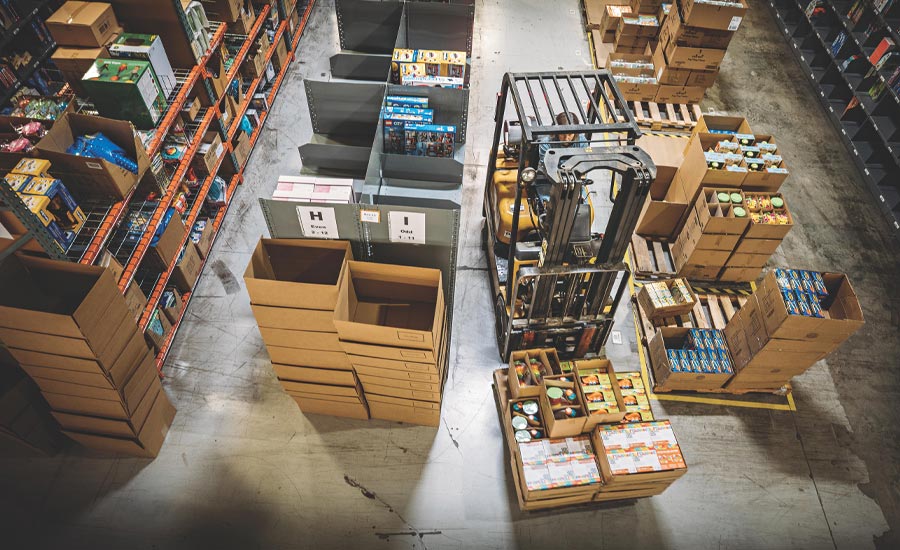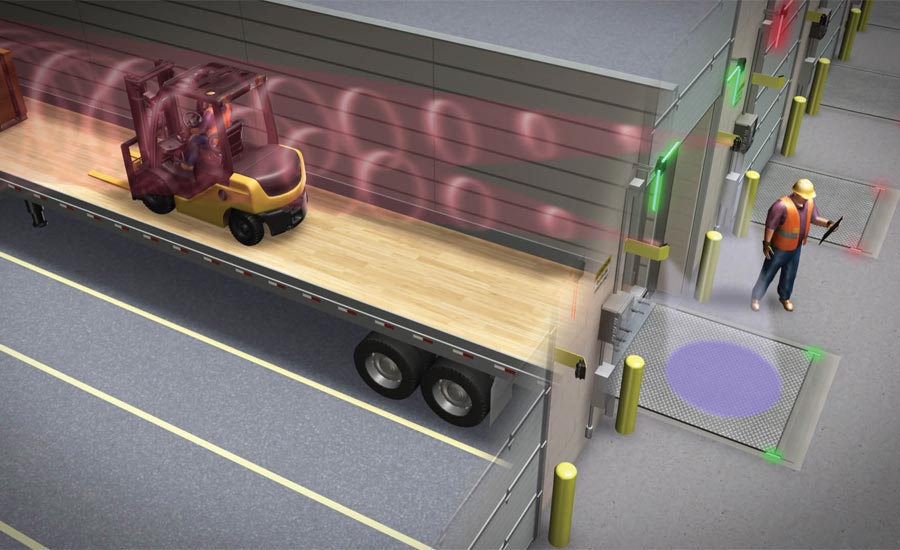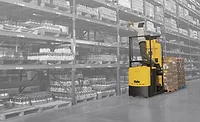Warehouse
Forklift safety, operator comfort remain priority for warehouses
Experts note that safety is key when it comes to forklift operations

Image courtesy of Yale Lift Truck Technologies
When performing a stunt in cheerleading, the flyer must trust the bases underneath them. The group — whether it be two, three, four or more — must all clearly communicate what the stunt combination is before going into it. Each cheerleader must trust that the others in their group are going to do their jobs as perfectly and as safely as possible. It’s especially vital that the group ensures the safety of the flyer, because the flyer is the one being thrown into the air. If the group is stunting in a careless or sloppy manner, injuries can occur.
For a warehouse to function smoothly, it’s important that everyone is on the same page about safety, especially when it comes to forklifts.
Mark Koffarnus, major accounts manager at Greenville, N.C.-based Yale Lift Truck Technologies, says there is “a spectrum of demand and readiness” when it comes to automation in warehouse operations.
While some are simply dipping their toes in, he notes that others “have done their homework about the potential benefits and have warmed up to the idea that robotic forklifts make real business sense and can help improve workflows.”
There are businesses who still view robotics as a future proposition, he notes, but many are becoming more tech-enabled. Koffarnus says operations that are best-in-class expect their material handling equipment to reflect smart automation design and technology integration.
“In today’s high-turnover warehouses, operations commonly depend on less-experienced employees or workers without substantial experience at a specific site,” he explains. “Distracted or inexperienced lift truck operators may drive too fast, cut corners too sharply or even drive through prohibited areas, which can lead to mistakes, damage and injuries.”
Koffarnus goes on to add that more than 7,300 forklift-related injuries happen every year. According to the National Safety Council, in 2020, the cost for each medically consulted injury was $44,000 — not including the cost of property damage.
“Compare the risks inherent in a staffing model that relies exclusively on people with one augmented by technology, in which robots follow programmed site-specific rules of the road, such as maximum speed or minimum distance from pedestrians,” he says. “The consistent, strong performance of their navigation technology and programming of site-specific rules enable robotic lift trucks to adapt to surroundings and real-time conditions, while strictly following safety protocols, helping lift truck operations reduce the risk of accidents, collisions or other safety incidents.”
Furthermore, Koffarnus states that robotic lift trucks can assist in employee turnover rates, as well as maximize workforce productivity rates “by automating repetitive tasks” — such as load transportation and receiving or depositing loads from elevated conveyor or storage locations.
Joe Ellestad, director of customer relations and sales support at Milwaukee-based Rite-Hite, says that the rise of automated guided vehicles (AGVs) has meant that the technology supporting forklifts has needed to change.
He uses the example of AGVs relying on exact trailer position to safely enter a trailer.
“If there’s too much trailer movement when an AGV enters a trailer or if the trailer didn’t back in squarely, AGV sensors can shut down,” Ellestad explains. “Supporting technology like stabilizing trailer restraints that use two heavy-duty, double-acting hydraulic cylinders can help minimize vertical trailer drop from 4 inches to only 1 inch during loading. Computer componentry in an AGV has a much better chance of handling this minor shift than a massive jolt.”
Jim Bunsey, director of commercial business development at the Washington, D.C.-based Propane Education & Research Council (PERC), notes that the shrinking pool of workers has caused the new strategies to make the best use of the current workforce.
“Automation has provided the opportunity to transition repetitive tasks and large machine operations, while maintaining the institutional and vocational knowledge of a workforce,” he says. “As automation increases the efficiency of warehouses, the demand on material handling and the fork truck in general is imperative. We need reliable 24-hour equipment that will be able to handle the load and demand with the fewest moves possible.”
Martin Buena-Franco, automation products marketing manager at The Raymond Corp., Greene, N.Y. notes that warehouses often use various forms of automation coverage to fulfill the specific needs of an operation in collaboration with individuals.
“This collaboration is driven by the ongoing necessity for substantial investments in automation and automated products, prompting many companies to adopt a hybrid work style that balances heightened productivity with consistent costs,” he explains. “The primary benefit derived from automation lies in transitioning high-value employees seamlessly from more repetitive tasks and enabling them to undertake more versatile and value-enhancing tasks.”
Buena-Franco goes on to say that AGVs are increasing in popularity because of their benefits and flexibility, which can be seen in dairy, brewing, and soft and hard drink facilities. Automation equipment adoption has been increased in repetitive and high-volume routes, he notes, especially in the areas of receiving, shipping and production.
“We expect the proliferation of AGVs to continue,” Buena-Franco adds. “Employees benefit from working upstream or downstream material handling areas or managing an AGV fleet, away from dull and repetitive tasks to where they can add more value to the facilities’ mission.”

Image courtesy of Propane Education and Research Council
Latest technology for lift trucks
Software and other technological advances have influenced newer lift trucks.
But for warehouses, lift truck technology isn’t for show, says Yale’s Koffarnus. He considers technology to be a key component for success.
“To put some numbers against that — an additional 5 billion square feet of warehouse space is needed to accommodate warehousing growth over the next few years, and each million square feet typically calls for 80 to 100 lift trucks to serve it,” Koffarnus explains. “Warehouses already face widespread labor and safety crises — employee turnover has hovered at nearly 50% in recent years, and the global workforce shortage is expected to reach 85 million people by 2030.
“Under these pressures, operations recognize the importance of seamlessly integrated technologies as part of their lift truck solutions to help them prioritize safety, free up workers to tackle more fulfilling tasks and clear sustainability targets,” he continues.
As an example, Koffarnus notes that operator assist technology can alert operators of potential hazards and help avoid them. Yale’s Reliant operator assist system automatically, proactively and carefully adjusts truck performance based on real-time conditions, while keeping the operator in control, he says.
PERC’s Bunsey points to lift truck technology that enables real-time communications for operational efficiency.
“On-board telematics and diagnostics tracking can tell forklift fleet managers and operators real-time information that can help better manage efficiency, speed, idle time, operator habits, safety and equipment maintenance needs,” he says. “As technology continues to advance, lift vehicles are becoming more environmentally friendly, with low nitrogen oxide propane-powered forklift engines.”

Image courtesy of Rite-Hite
Taking comfort and safety into consideration
When developing forklift solutions, Yale’s Koffarnus notes that manufacturers must take ergonomic factors into account.
“As part of our blueprinting process, we spend hours interviewing and observing lift truck operators and customers to enrich our understanding of how they use the truck and the realities of their applications,” he explains. “Our engineers work with our industry-focused teams, such as those that specialize in beverage industry operations, and outside experts to translate operator, customer and industry or application-specific needs to functional features and designs.”
As a result of this process, Koffarnus says that ergonomic features on the company’s top warehouse models include power-assistive automotive-style steering, generous space in operator compartments, cushioning that reduces shock and vibration, as well as designs that maximize visibility.
He emphasizes that forklift safety isn’t an outcome, but a culture, and something that “is everyone’s job and must extend across operations and the supply chain.” Koffarnus says that a culture of safety begins with a strong operator training program.
Rite-Hite’s Ellestad voices that driving over levelers multiple times a day “can be jarring to forklift operators.” This is known as “dock shock,” which can lead to long-term back pain and injuries.
“Levelers with smooth transition technology utilize design trains like a constant-radius near hinge to reduce bumps and gaps at the rear of the dock leveler and two-point crown control on the front lip hinge to distribute the load evenly,” Ellestad explains. “An optimized lip chamfer can improve the smooth ride by another 20%. It all helps to lower employee injuries, minimize product spills and damage, and increase productivity.”
Ellestad says that safety measures, like blue lights affixed to forklifts, are being instituted into today’s forklift technology. The blue lights help announce the presence of a truck to others in the facility, and it’s a policy that Rite-Hite has adopted with products like the Pedestrian-Vu.
“A blue light shines down on the leveler when forklift activity is detected inside a trailer, which extends the warning time for employees inside the loading dock,” he explains. “Additionally, when the Pedestrian-Vu is interlocked with the generation 2 Dok-Commander controls, the Dok-Lok remains engaged with the trailer to help prevent the truck from unexpectedly pulling away with a forklift in the trailer.”
Inside the facility, Ellestad notes that products such as the Safe-T-Signal Warning System shine a blue light in the center of blind intersections when multiple forklifts are approaching.
PERC’s Bunsey says that ergonomic handle design on propane cylinders allows for easy lifting and swapping. He notes that composite propane cylinders are “a safer, lighter alternative” to cylinders made of steel and aluminum.
“Additionally, aftermarket swing out and down propane tank brackets make it faster and safer to change an empty cylinder for a full one,” Bunsey says. “With safe and efficient on-site refueling systems designed for forklifts, refueling takes less than five minutes.”
He adds that, in terms of safety measures, it’s best to ensure that crews are following the basics of safety — such as buckling up, wearing personal protective equipment, staying within weight capacity, carefully handling cylinders and using proper lifting techniques.
Busney suggests regular training sessions will keep safety top of mind for workers. Further, for facilities using propane forklifts, he points to taking advantage of safety training opportunities from local propane suppliers.
Raymond Corp.’s Buena-Franco expresses that any lift truck poses ergonomic concerns, especially in regard to the demands of a full shift and operators getting on and off the truck. Because skilled labor remains scarce, he notes that operations should seek equipment that prioritizes operator friendliness and ergonomic features.
“At Raymond, we prioritize ultimate operator comfort and ergonomics in the design of our forklifts,” Buena-Franco says. “We achieve this through larger operator compartments and strategically placed ergonomic controls, reinforcing best practices and ensuring our operators feel comfortable and perform at their best throughout their shifts.”
Like Koffarnus and Busney, Buena-Franco emphasizes the importance of safety training, primarily with new operators.
Steering towards sustainability
Yale’s Koffarnus says that, as sustainability initiatives become more aggressive, businesses are electrifying their lift truck fleets to meet regulations and cut costs. He notes that the company aims to provide choices and guidance to help operations choose which solutions best fit their sustainability and operation needs.
“To that end, Yale Power Key is a new technology [that] allows warehouses to easily transition between lead-acid, lithium-ion and thin plate pure lead (TPPL) battery power without the use of external accessories,” he explains. “This sort of technology can be particularly valuable for operations that have mixed fleets and need to continue to use lead-acid or are planning to transition to a fully maintenance-free fleet over time, equipment used at multiple sites within an operation, the electrification of internal combustion (ICE) fleets and more.”
PERC’s Busney shares that, when compared with electric, propane can reduce sulfur oxide emissions by 76%. Compared with diesel forklift engines, propane forklift engines can produce up to 97% fewer hydrocarbon and nitrogen oxide emissions, he says.
“As more renewable propane becomes available, fleets will be able to further reduce emissions,” he explains. “And with new propane power generation technology, fleets can even recharge their electric lifts with clean, reliable propane.”
Moreover, with the development of renewable propane and other clean energy alternatives, Busney suspects that the carbon footprint of newer and older forklifts “can be significantly reduced.”
|
Beverage trends influencing lift trucks Market trends in the beverage industry also are affecting forklift operations. Mark Koffarnus, major accounts manager at Greenville, N.C.-based Yale Lift Truck Technologies, points out that rising consumer demands have presented a two-fold challenge for beverage operations, because they must store and move a larger selection of SKUs, while meeting elevated expectations for that selection to consistently be in stock. “Lift trucks can help to speed up the picking process and get orders out the door on time, especially those with productivity-enhancing designs that provide greater maneuverability or are powered by lithium-ion batteries with fast charging times and a long battery life,” he says. Jim Bunsey, director of commercial business development at the Washington, D.C.-based Propane Education & Research Council (PERC), suggests that, while many distributors use a combination fleet of electric and propane forklifts to move product, smaller distributors often opt for propane lifts because they’re versatile and efficient in all settings, whether it’s indoor or out, or hot or cold. “Propane forklifts can operate continuously, stopping only for a cylinder exchange or operator break; however, electric lifts have a finite operating time before a multiple-hour recharge is needed,” he notes. Martin Buena-Franco, automation products marketing manager at The Raymond Corp., Greene, N.Y., also says that, as companies are expanding the number of suppliers and locations, the result has been more SKUs. Technology needs have increased as businesses have grown, too, he expresses. “Furthermore, maintaining order accuracy is paramount, prompting companies to seek a standardized operator experience and enhanced visibility into picking, labor and costs,” Buena-Franco says. “Finally, the industry faces prevalent labor challenges, driving companies to search for a uniform method to train and retrain operators across multiple pieces of equipment, spanning the entire operation from top to bottom.” |
Looking for a reprint of this article?
From high-res PDFs to custom plaques, order your copy today!






